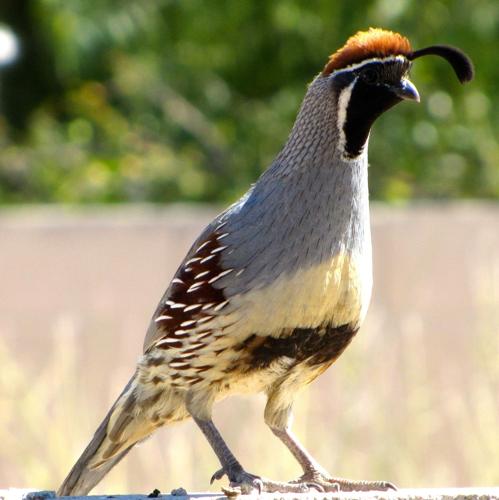Here in SaddleBrooke, summer months are nursery months for baby quail. We see Greater Roadrunners year-round, but we see a lot more of them during baby quail season. Roadrunners are drawn to baby quail like seafood addicts are drawn to popcorn shrimp.
Gambel’s Quail
There are three species of quail found in Arizona: Scaled, Montezuma and the one common to SaddleBrooke, Gambel’s. Similar to the California Quail, Gambel’s Quail (Callipepla gambelii) is a non-migratory bird well adapted to life in the suburbs. They are beautiful 10-inch birds that prefer walking to flying. When they do fly, their short, rounded wings produce explosive and noisy takeoffs. Both females and males have a distinctive topknot, and the male is particularly striking with his dark face, forehead and abdomen. They are so common here that many of us may take them for granted and miss the ongoing beauty pageant. If you have binoculars, take the time to study their coloration and topknots. The male is often seen perched on a wall or other high point, acting as a sentry while the rest of the entourage forages below. Their diet is almost exclusively the leaves, seeds, flowers and shoots of plants, and they scratch their way across the terrain like chickens.
Except when breeding, quail are gregarious and often found in groups. Social convoys form after the young hatch, sometimes consisting of several families. Normally only one brood is produced annually, with up to 15 eggs, although two females may lie in the same nest. “Nests” might be an exaggeration, since you are likely to find a bunch of quail eggs under a bush or in a pot. We found a single egg lying on our patio one day, stuck it in a nest with 15 other eggs under a bush, and all 16 eggs later hatched successfully. Quail young hatch synchronously (together) three weeks later, and are precocial, walking out of the nest and foraging within hours. And a good thing, too, with salivating roadrunners waiting in the wings.
The Greater Roadrunner
The Greater Roadrunner (Geococcyx californianus) is a big bird, 23 inches long and with an equivalent wingspan. Like quail, roadrunners prefer walking to flying, and, living up to their name, they also like to run. Almost as fast as their cartoon caricature, roadrunners can reach 15 miles per hour, which is a lot faster than a quail. The state bird of New Mexico, the Greater Roadrunner is comical (he’s in the Cuckoo family, after all), raising his crest, looking quizzical and slowly raising and lowering his long tail. Far from being a comedian, however, this is a bird with a mean streak, a necessary trait when you like to eat rattlesnakes. They aren’t model parents, either, often stopping incubation of their other eggs once the first one or two hatch. Roadrunners are fearless, as you know if you have ever tried to drive one out of your quail-populated yard. They are non-migratory meat eaters, with an appetite for snakes, lizards, rodents and baby quail. They also love sausage and hamburger, and you can find them on the patio at the appropriately named Roadrunner Grill and at the Marketplace’s In ‘n Out Burger.
Baby quail have a high mortality rate for lots of reasons. Anyone who enjoys watching them follow their mother in a single file, like little windup toys, knows that the 15 you counted Tuesday is likely to be 13 Wednesday and into single digits by the weekend. The roadrunner, with those tiny quail feet sticking out of his bill, is the usual suspect. No wonder quail have large broods of chicks ready to scramble at birth.
If you have questions or comments about SaddleBrooke’s birds, or to receive emailed information about bird walks led by Bob and Prudy, call 825-9895 or email bobandpru@aol.com. Previously published articles can be found at www.birdingthebrookeandbeyond.com.






